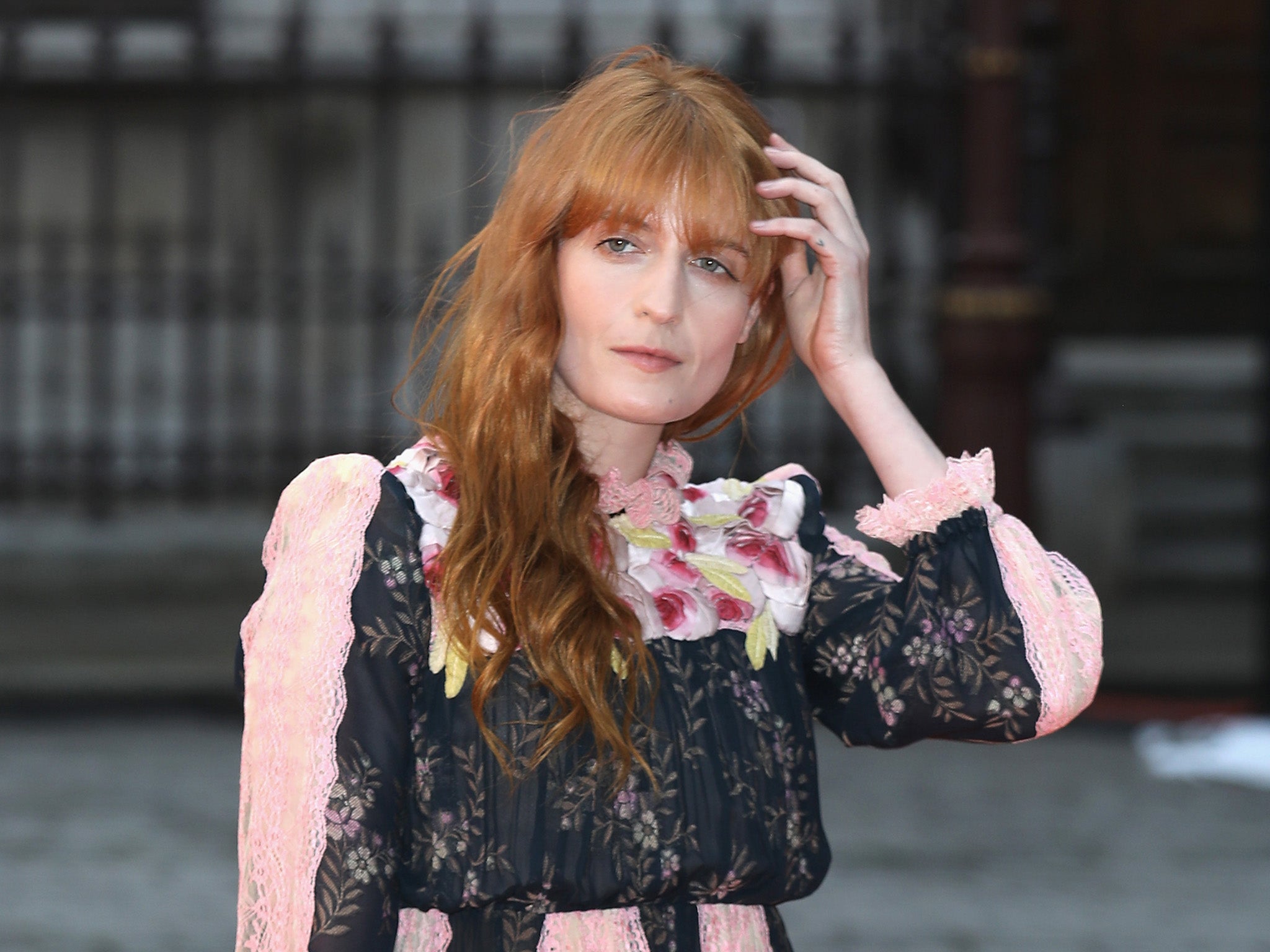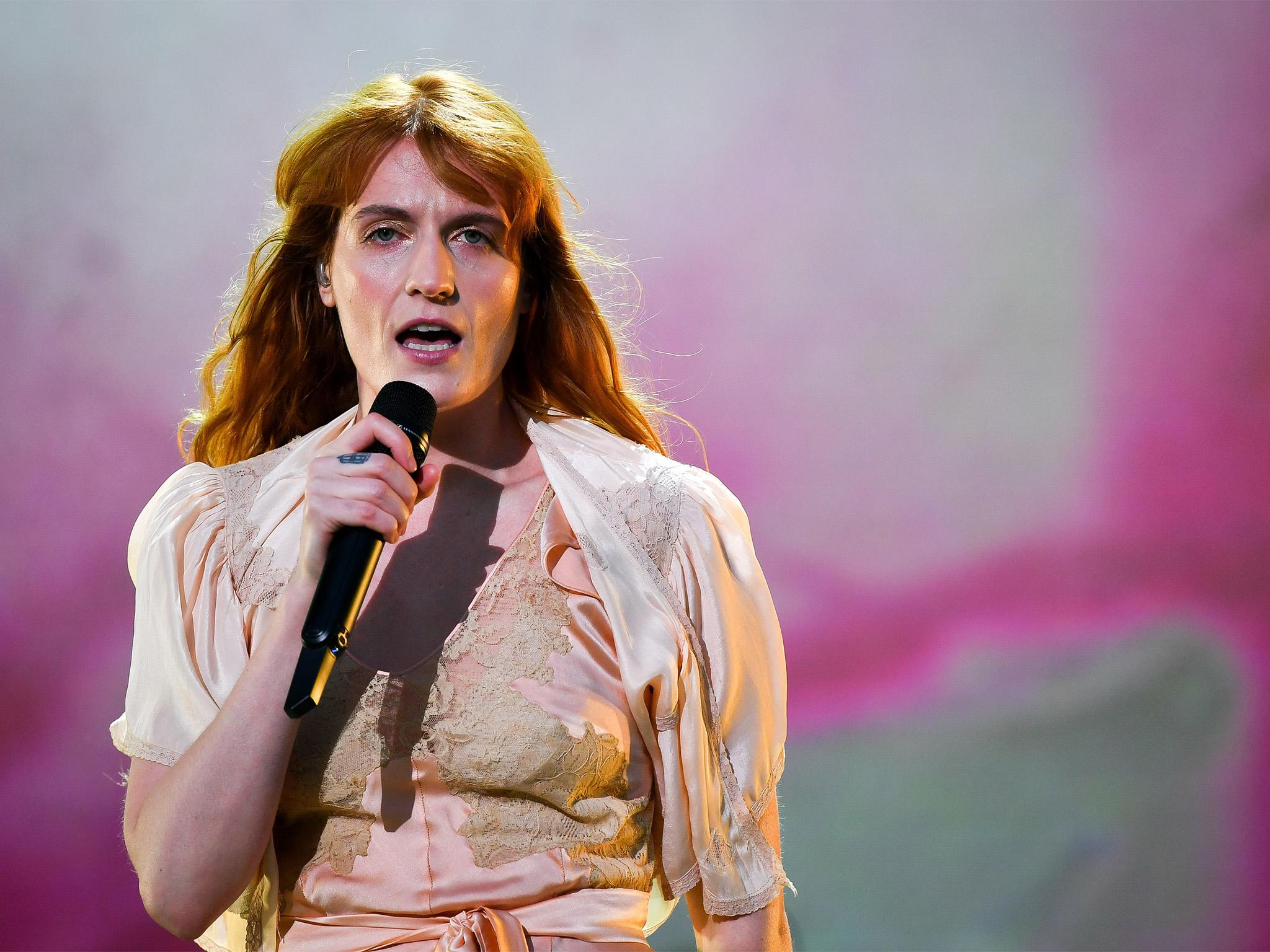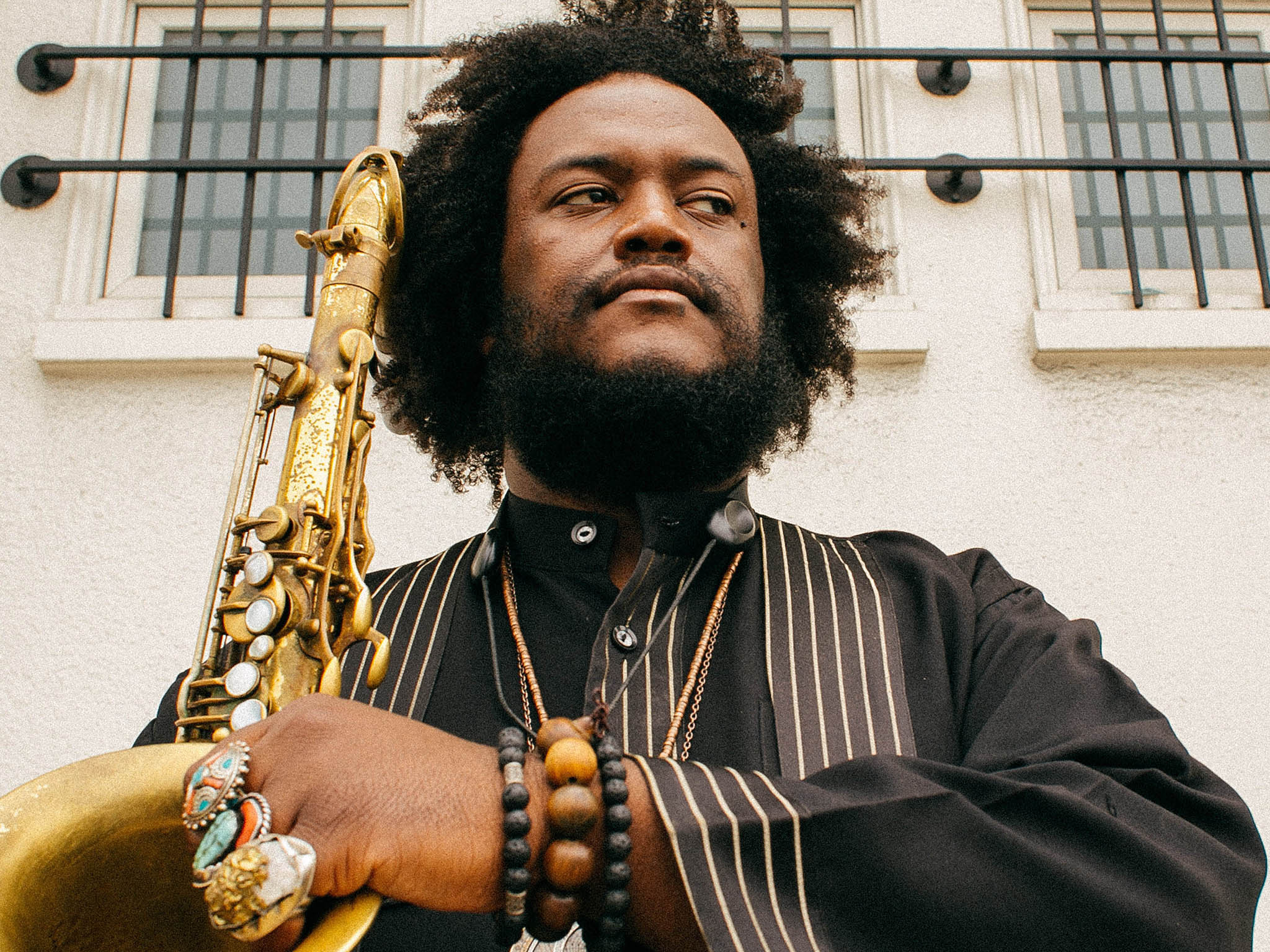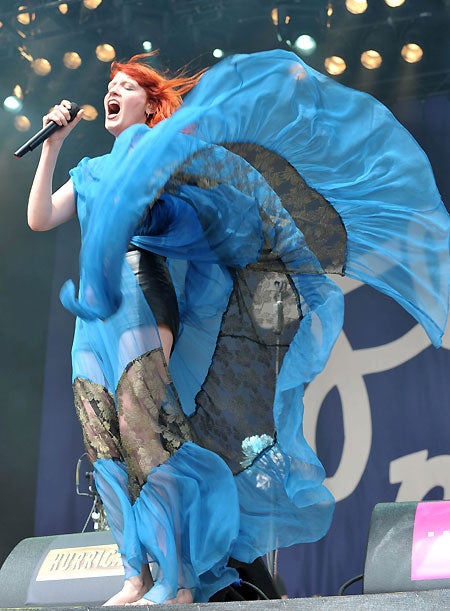Florence Welch on embracing her femininity: 'You can still be strong and scary in a pink nightie'
As she releases new album ‘High as Hope’, the singer discusses quitting drinking, spiritual confusion and why she had to write a song about her teenage eating disorder

Your support helps us to tell the story
From reproductive rights to climate change to Big Tech, The Independent is on the ground when the story is developing. Whether it's investigating the financials of Elon Musk's pro-Trump PAC or producing our latest documentary, 'The A Word', which shines a light on the American women fighting for reproductive rights, we know how important it is to parse out the facts from the messaging.
At such a critical moment in US history, we need reporters on the ground. Your donation allows us to keep sending journalists to speak to both sides of the story.
The Independent is trusted by Americans across the entire political spectrum. And unlike many other quality news outlets, we choose not to lock Americans out of our reporting and analysis with paywalls. We believe quality journalism should be available to everyone, paid for by those who can afford it.
Your support makes all the difference.The day that Florence Welch got “Always Lonely” tattooed in blocky print on her left arm, she was not lonely at all. She had spent a blissful day traipsing around New York with a close friend, visiting book shops, savouring ice creams and coffee, feeling enamoured and alive with the city’s possibilities. She wrote a poem about it, “New York Poem (for Polly)”, which contained a line that became the title of the fourth Florence and the Machine album, High as Hope:
Heady with pagan worship
of water towers
fire escapes, ever reaching
high as hope.
And yet there she was, in an East Village tattoo shop, getting that sad phrase inked on her body while her Polly looked on. Welch, the effervescent leader and songwriter of pop-rock band Florence and the Machine, has made a speciality of wringing joy from despair, so she did not think twice about exposing her loneliness.

“I thought that I would just cement it,” she says, “because maybe if I just had it on there, I could own it somehow, make it a part of myself, or embrace that part that I find difficult.”
Welch, 31, is lately very ready to showcase her self-acceptance. Her New York poem is collected in Useless Magic, a book of her lyrics, poetry and drawings that’s out in July. High as Hope, due on 29 June, is full of secrets she never thought she would share, let alone sing and dance about in front of fans. Even for an artist who makes anthems out of the confessional – a painful breakup fuelled How Big, How Blue, How Beautiful, the group’s last album – High as Hope represents a new openness, and a new confidence, for Welch.
“I made myself more vulnerable and made a step away from the metaphoric,” she says on a recent afternoon at the Bowery Hotel. “It created a creative bravery. I was like, it’s OK to put yourself out there.”
It was a path she had been on since 2015, with the No 1 How Big, but even then “I still felt I had something to prove”, she says. “This one, I had a lot of joy in making it.”
She comes in jangling, but takes off her golden charm bracelets – too noisy for an interview, she says, though their clink is all over the album. “It was a very physical record,” she says, “very tactile. Really, the thrill of making a sound has never left me.”
The Bowery Hotel is her regular haunt, despite the fact that she once set fire to her room there. A votive candle lit up a wall; in her post-party haze, she did not even notice until the next morning.
More alarming: her bar tab was higher than the bill for room damages. Welch stopped drinking a few years ago. “It just opened up doors for me that I don’t know how to shut,” she says. High as Hope is the first album she has made from both a sober and emotionally uplifted place.
Enjoy unlimited access to 100 million ad-free songs and podcasts with Amazon Music
Sign up now for a 4 month free trial (3 months for non-Prime members)
Enjoy unlimited access to 100 million ad-free songs and podcasts with Amazon Music
Sign up now for a 4 month free trial (3 months for non-Prime members)
“Florence has definitely gone through a transformation,” says her bandmate Isabella Summers, with whom Welch began playing music in her teens in south London, where she grew up. Summers, who plays keys in the group, went on to help produce and write some of Welch’s early work, including the 2009 breakout “Dog Days Are Over”.
“The first time I really found my sound was working with another woman, working with Isa,” Welch says. “As a young artist, you can struggle to find your voice, and it takes a while to say no, I want it to be like this.” Now, she adds: “I’m very OK with being in charge. Because I know that I know what I’m doing.”
For this album, Welch took a producing credit for the first time. She spent six months just making demos, mostly on her own.

One of the most challenging songs was “Hunger”, the second single. Its opening line – “At 17, I started to starve myself” – is a reference to an eating disorder that Welch struggled with as a teenager.
“I never thought I would talk about it,” she said. “I didn’t really talk about it with my mum until really recently. So to put it in a song – it’s like, what am I doing?”
She worried that people would be angry with her for discussing it, and tried to convince herself to take the line out – the rest of the lyrics deal more obliquely with emptiness. But the song was not as powerful without it. She thought about throwing the whole track off the album, but, she says, “it’s at the heart of it”.
Her revelation stayed, and it helped her own understanding. “It definitely was a release for me,” she says. “The songs sometimes have more clarity in them than I do about my life.”
Welch declines to go into greater detail about her eating disorder, for fear that others would model themselves after her. “When I was in it, I was always, like, hunting for information,” she says. “I want to be responsible.”
Working with producer Emile Haynie (Lana Del Rey’s Born to Die), High as Hope centres, as always, on Welch’s muscular, emotional voice, which can go from ecstatic to mournful in one lilt. The tracks build from piano and earnest percussion towards sometimes lavish instrumentation; the saxophonist Kamasi Washington did arrangements for French horn, tuba, flute and bass clarinet.

Washington, who also plays on the album, signed on quickly – he had ideas the moment he heard the demos. “The thing for me was trying to add without taking away what she had already put in there,” he says. He called Welch a kindred spirit, comparing her to another of his collaborators, Kendrick Lamar, in the purity of her love for music and her freedom to follow where the tune goes in the studio.
“It was really cool, every time we’d finish recording, we’d go in the room and she’d have all new vocal parts that she’d created while we were recording the horn parts,” he says.
In a two-hour conversation, she laughs often and robustly. In the hotel lounge, she spills her secrets in a voice loud enough to demonstrate she does not care who else hears; she has the surprisingly rare ability, as an artist, to translate how her emotions and music intersect. “You know, having an overactive mind and overthinking stuff, and being anxious – ever since I was a kid, if I had a song that I could follow, everything would become very calm,” she says. “It was like this cocoon that I could go into.”
Almost as soon as she came on the scene, Welch became a fashion industry darling, but her ethereal look was nearly coincidence, says Tom Beard, a director and photographer who began shooting the musician when they were students at Camberwell College of Arts in south London in the mid-2000s, and continued to create her album covers. The first photos he took of her, at a festival, she wore a pink dress and elf ears; Summers, her bandmate, remembers this period as being full of glitter. Only after Beard and Welch checked out an exhibit of Pre-Raphaelite art at the Tate museum did she transition to her much-copied flowy boho goddess aesthetic, he says.
For the tour after How Big, How Blue, How Beautiful, Welch experimented with a more androgynous (for her) style, all angular suits. It was, she says, a reaction to her heartbreak: “I was almost angry at the more vulnerable, feminine sides of myself, because they seemed weak.” But it felt like a pose.
Now, she says, as she’s collapsing the boundaries between her on and offstage life, she wants to wear more real-world clothes – even sleepwear. “On this record, I was embracing the femininity, embracing the things I really liked, embracing that you can still be powerful and strong and scary in a pink nightie,” she says.

Beard, her friend since her earliest days as an artist, says she is now being more truthful than he’s ever seen. “It’s the confidence of 12 years,” he says. “What she’s putting out there is the Flo that I know and I’ve always known.”
Listening to her record in the studio, he says that he welled up. “When you’re not holding anything back, no one can hurt you anymore, can they?” he says. “Whatever was hurting her, I can just hear it in her voice, how collected she is now. She’s comfortable with the person that she is.”
Her autumn tour for High as Hope is her biggest yet. At a preview show at the Brooklyn Academy of Music last month, the stage heaved with flowers and moss and baby’s breath hung overhead, like clouds. Beforehand, she had joked that the tour “could be called ‘On Nightgowns and Spiritual Confusion’, because that’s what it is, I’m in a nightgown being confused about things in a loud way.”
But when she walked onstage, de-accessorised and barefoot, in a shell-pink lingerie gown and lace-edged bed jacket, there were no doubts. She stalked the floor with the fervour of a preacher, raising her arms in exaltation and executing balletic spins. In the end, she made her way into the crowd, for a communion.
“Tell someone you don’t know that you love them,” she instructed. “Make it awkward.”
In real life and in performance, Welch is looking for connection. “I quite like the idea of putting really big, unanswerable spiritual questions in pop songs,” she says. “We can be together in this moment, and celebrate the not knowing, and perhaps feel closer to each other. We can jump up and down. If you just dance about it, you will feel better.”
‘High as Hope’ is released on 29 June
© The New York Times
Join our commenting forum
Join thought-provoking conversations, follow other Independent readers and see their replies
Comments